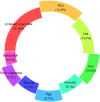Applying Market Basket Analysis to Determine Complex Coassociations Among Food Allergens in Children With Food Protein-Induced Enterocolitis Syndrome (FPIES)
- PMID: 39071726
- PMCID: PMC11274009
- DOI: 10.1177/23333928241264020
Applying Market Basket Analysis to Determine Complex Coassociations Among Food Allergens in Children With Food Protein-Induced Enterocolitis Syndrome (FPIES)
Abstract
Background: Food protein-induced enterocolitis syndrome (FPIES) is a non-IgE-mediated food allergy, characterized by delayed onset of repetitive vomiting occurring 1 to 4 h following ingestion of a food allergen. Managing FPIES requires strict avoidance of the food trigger. The concern with FPIES is determining the risk of another FPIES food trigger reaction due to potential coassociations with other foods or food groups. An effective statistical approach for analyzing FPIES-related data is essential to identify common coallergens and their associations.
Methods: This study employed Market Basket Analysis, a data-mining technique, to examine correlations and patterns among allergens in FPIES patients at a Houston, Texas, pediatric tertiary center. A retrospective analysis of electronic medical records from January 2018 to March 2022 for allergist diagnosed FPIES patients was conducted. The analysis utilized R software, specifically the "arules" and "arulesViz" packages, implementing the Apriori algorithm with set minimum support and confidence thresholds.
Results: The study included 210 FPIES cases over 4 years, with 112 patients reacting to one food trigger and 98 to more than one trigger. In the latter group, the 5 predominant triggers were cow's milk (45.9%), rice (31.6%), oats (30.6%), soy (22.4%), and avocado (19.4%). Market Basket Analysis identified significant associations between food categories, particularly between soy and dairy, egg and dairy, oat and dairy, rice and dairy, and avocado and dairy.
Conclusion: Market Basket Analysis proved effective in identifying patterns and associations in FPIES data. These insights are crucial for healthcare providers in formulating dietary recommendations for FPIES patients. This approach potentially enhances guidance on food introductions and avoidances, thereby improving management and the quality of life for those affected by FPIES.
Keywords: epidemiology; food allergens; market basket analysis.
© The Author(s) 2024.
Conflict of interest statement
The author(s) declared the following potential conflicts of interest with respect to the research, authorship, and/or publication of this article: SA receives research grant funding from NIH/NIAID and DBV. SA serves on the medical advisory board for the International FPIES Association (iFPIES). NLR receives research grant funding from NIH/NIAID, Takeda Pharmaceuticals and The Jeffrey Modell Foundation. NLR also serves on the following scientific advisory boards: Takeda and Pharming Healthcare. NLR receives royalties from Wolters Kluwer for contributions to UpToDate.
Figures



References
-
- Nowak-Wegrzyn A, Chehade M, Groetch ME, et al. International consensus guidelines for the diagnosis and management of food protein-induced enterocolitis syndrome: executive summary-Workgroup Report of the Adverse Reactions to Foods Committee, American Academy of Allergy, Asthma & Immunology. J Allergy Clin Immunol. 2017;139:1111-1126 e1114. 2017/02/09. doi:10.1016/j.jaci.2016.12.966 - DOI - PubMed
-
- Groetch ME, Atal Z, Nowak-Wegrzyn AH. Quality of life and feeding difficulties associated with childhood FPIES and IgE-mediated food allergies. In: 2016 AAAAI Annual Meeting 2016.
-
- Agrawal R, Imieliński T, Swami A. Mining association rules between sets of items in large databases. Proceedings of the 1993 ACM SIGMOD International Conference on Management of Data; 1993:207-216.
LinkOut - more resources
Full Text Sources

